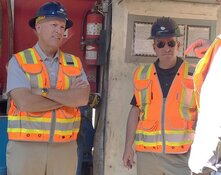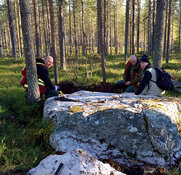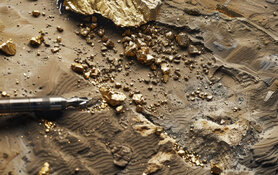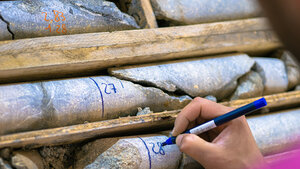Doug Groh: What we're seeing in the world is really quite dramatic, isn't it? I think people are beginning to recognize that there's a lot of uncertainty in the future for financial markets. The attraction that gold presents is that it is a hard asset. It's valued on the minute and on the second. There's been a lot of distrust in the marketplace regarding the paper that's been issued, whether that's equity paper or bonds or currency. I think investors are looking to something that really sustains and exhibits value on a moment-to-moment basis.
TGR: What do you think the near-term effect of the sovereign bailout of Greece is going to have on gold?
DG: From day to day, there is a lot of uncertainty as to what's going on with Greece and in Europe. We're seeing the euro correct. We're seeing the dollar strengthen, but I think what's really noteworthy is that gold is holding its own. In prior markets, you would typically see that when the dollar strengthens gold comes off. Now we're seeing gold actually rise in all currencies. That is a reflection of the concern and distrust for central bank and political authorities, and what's going in the world that we're living in. The markets are reflecting their concern about inflation. To resolve the Greece problem, its debt probably needs to be restructured if not go into default. That probably means a greater issuance of credit, which in the end is inflationary. Debasing the currency is what you're going to see. In that regard people are concerned and focused on maintaining and holding on to whatever value they can, and gold is becoming that much more attractive.
TGR: There is talk that Greece will no longer be allowed to use the euro. Is this crisis coming to the U.S. in a big way?
DG: We're learning and understanding that all global markets are very interconnected; contagion will probably affect us somehow, but to what degree and in what capacity? I really don't know. However, one has to think that international banks operating around the world are going to be affected.
TGR: How are investors getting exposure to gold?
DG: What we've seen over the last several years is investors seeking gold through ETFs. The gold ETF has done a fantastic thing for the gold market. It's made gold more accessible, not only to institutional investors, but also to the individual investor. As a result, more people are embracing and adding gold to their portfolio. It's been a good diversification position for investors. Gold's success over the past ten years has basically reinforced the notion that gold is a legitimate investment vehicle. In the past, I think investors thought of gold as something you go to only during times of distress or inflation or geopolitical concerns. And while that is likely to continue, gold has also demonstrated that it is a good diversifier among other portfolio holdings. The performance of gold over the last 10 years has really demonstrated that it should be an important component in portfolios.
TGR: About 9% of your $1.3-billion fund is physical gold. That's the largest holding in your fund. By comparison, the Sprott Gold and Precious Metals Fund doesn't list any physical gold among its top-10 holdings. Please expand on your strategy in holding so much actual bullion.
DG: We have about $11 million of gold, which makes up about 8%–9% of the fund. That's a position we've had for some time. Our average cost is about $450 an ounce for the gold we hold. We built up that position some time ago. As we were getting cash in-flows, we were deploying cash to bullion as we felt some of the equities were overpriced. That has worked out well. The position acts as a balance. The majority of our fund, 80%-85%, is gold mining equities. There is almost twice as much volatility in gold mining equities as in gold. The fact that we have bullion in the fund somewhat dampens that volatility. Bullion acts as a ballast, of sorts, which reduces the risk in terms of investing in the fund.
TGR: Have you noticed that happening over the last month or so?
DG: That was the case this past year. We've seen days when the gold price is up and sometimes the equities are down. We've actually had nice relative performance from that type of activity where sometimes we'll see the equities down but bullion up . There are days when gold seems to be the attraction and people are really looking for that direct exposure to gold bullion. It's been a nice balance to the fund, and has really added a lot of value in terms of relative performance.
TGR: What sets your fund apart?
DG: I think it's the smaller names that may not have as much public information out there. That's really where we focus. You could say that we have a small cap value bias concentrated in global gold mining equities. We focus on precious metal companies that are making discoveries and growing that way or that are expanding either their assets or production. Typically, those companies require a little bit more due diligence and fuller understanding. They are quite dynamic. It's really something that I think is not easily understood unless it's something you do on a regular basis. The gold mining sector is very information-intensive and it becomes imperative that, as an investor, one stays in the flow of information. That’s a full-time job for the all the companies we own and track.
TGR: In terms of your asset mix, you have roughly 10% bullion and the rest is gold equities. Investors may look at your fund and think they should employ a similar strategy. Is that a mix that regular investors should be looking at?
DG: I think that's a good approach. If you're looking at exposure to the gold market, I think it's appropriate and wise to have direct exposure to gold. In owning a gold mining equity you get optionality on the gold price. You get a higher level of risk return. As we discussed, direct exposure to gold bullion will allow one to have direct exposure to the gold price and yet owning gold mining equities, which are more volatile, allows one to gain exposure to pricing and asset leverage. A bullion position will dampen down volatility a little bit. Then, if you are exposing yourself to gold mining equities, I think it's appropriate to spread your risk across a number of names—in particular to different segments of the gold mining industry —those being explorers, developers and producers.
The explorers tend to be a little bit riskier but can offer some good upside as they add value through discovery. The developing companies that are growing tend to appreciate in value as they realize their growth objectives, but they do present some risk, since their growth is uncertain. Then, of course, there are the big producers who, to a large extent, really offer price optionality on gold.
TGR: Can you tell us about some of the bigger gold equities in your top 10, like IAMGOLD Corporation (TSX:IMG;NYSE:IAG), Newmont Mining Corp. (NYSE:NEM) and Goldcorp Inc. (NYSE:GG ;TSX:G)?
DG: Those are major producers that are actually producing gold and generating cash flow. They offer price optionality or leverage to the gold price. Generally speaking, a move in the gold price is going to directly affect their bottom line. If the gold price goes from $1,200 to $1,300, that $100 of movement in the gold price is going to fall right to their bottom line and the market is going to revalue that profit directly into the stock. Typically, you get a 2% performance in gold equities relative to a 1% performance in gold bullion. So that's the kind of optionality you get in the major names, such as IAMGOLD.
IAMGOLD has a great balance sheet. It has a number of different operations around the world. You have some really nice diversification there. It is building some mines, which will add to its production profile, so you're getting some growth too.
TGR: Are you talking about Essakane in West Africa?
DG: Yes, the Essakane project in Burkina Faso should be coming onstream in the next year or so. Commercial production at the Westwood project in Quebec is expected in 2013. In South America, they have developing projects in Guiana and in Ecuador, which will add to their profile in time. Newmont doesn't have the same type of growth profile as IAMGOLD. It is a larger producer and is really more tied to price optionality. However, Newmont's balance sheet is improving significantly and it holds a lot of cash. It's likely to be an acquirer of assets in order to do two things: grow and replace depleting resources.
TGR: And Goldcorp?
DG: Goldcorp has had a nice string of success with not only the assets they've acquired but the ones that they are developing. They have a very dynamic growth profile. I think they are in a very strong position to use their balance sheet and their valuation to continue a growth profile well into the decade.
TGR: Are you talking about Peñasquito in Mexico?
DG: Peñasquito and some of its assets in Canada at Red Lake and the Éléonore project in eastern Canada. They have quite a diverse mix of assets, which really gives them a lot of flexibility.
TGR: Other than Osisko Mining Corp. (TSX:OSK), which makes up about 5% of your fund, what other precious metals juniors do you like?
DG: We have a sizeable position in International Tower Hill Mines Ltd. (TSX:ITH;NYSE.A:THM). It's a similar story to Osisko in a way, and yet it's maybe several years behind the development that Osisko is undertaking. International Tower Hill has a project in Alaska in the Livengood district—a former gold-producing area in central Alaska. The people running International Tower Hill are from Cardero Resources Corp. (TSX:CDU, NYSE.A:CDY, Fkft:CR5) and AngloGold Ashanti Ltd. (NYSE:AU;JSE:ANG;ASX:AGG;LSE:AGD).
TGR: What's Tower Hill's story?
DG: Basically they've gone back into this historic producing district, redefined the geology and identified a much larger deposit of relatively lower-grade gold but in high volume. It's interesting because majors like Newmont or Barrick Gold Corp. (NYSE:ABX;TSX:ABX), which are producing 5–8 million ounces a year, need to replace that production. International Tower Hill has found a sizeable project that could potentially be part of a major. AngloGold is already a sizeable investor in International Tower Hill and that's something we're rather excited about. The fact that it's in the United States gives us that comfort of knowing it's not in a jurisdiction that could be a little bit more politically sensitive.
TGR: What other juniors are you following?
DG: We have a major position in Ivanhoe Mines Ltd. (NYSE:IVN; TSX:IVN). The attraction there is it has a sizeable world-class project in Mongolia, which is not only gold but also copper. The Oyu Tolgoi project has attracted interest from Rio Tinto Ltd. (LSE:RIO;NYSE:RTP;AUS:RIO) as an investor in Ivanhoe. Rio Tinto can take its equity interest up to a higher level over time by providing more capital. What's interesting is that it's in a part of the world where copper and gold is in demand, particularly from China. So you have an active and demanding market for the copper. Clearly, the fact that there's gold there adds value to the deposit and makes it easier and cheaper to mine the copper.
TGR: It seems that gold companies are looking more frequently at copper-gold porphyry projects because of the boost they get from the copper. For example Northern Dynasty Minerals Ltd. (NYSE.A:NAK;TSX:NDM) owns the Pebble project in Alaska that contains billions of pounds of copper, as well as around 40 million ounces of gold in all categories. Are majors more likely to acquire projects that are copper-gold porphyry deposits now than straight gold deposits?
DG: I think there's been developing interest over the last year or so toward what's called copper-gold porphyries. The reason for that is that having a byproduct metal can help reduce the cost or generate greater revenues, which helps justify a project’s economics. That's certainly an important element. I think the other aspect is that clearly the copper price has been quite strong at over $3 a pound, and copper is not to be ignored. There's a lot of demand for copper. That's likely to continue. I also think—and this might be the key element that's not that well discussed—but typically and generally speaking, copper-gold porphyry deposits are large in scale and there's a lot of metal in them. As these major companies need to replace their resources, they're looking for a project that will provide them a long-life of output. Generally, it seems as though you're finding that in copper-gold porphyry style deposits; epithermal deposits can also have high volumes but maybe not quite as large and the same could be said about volcanic massive sulphide deposits or sediment hosted deposits.
TGR: Obviously the market cap of a company like Northern Dynasty is quite substantial now that they've outlined a significant resource. What about something on the edge of a play like that, such as Kiska Metals Corp. (TSX.V:KSK)?
DG: I think that's where you want to go to find some exciting value opportunities. If you look at the life cycle of a mining stock from exploration to development to production, the greatest value generation is during exploration. Certainly, there's value created during development as a company goes through the process of permitting and financing and building a mine. A company like Kiska, which is also operating in Alaska, is really at the front of the curve here in terms of exploring and identifying a significant deposit. For a small company to find a deposit, the value-add can be tremendous.
TGR: Tell me about its Whistler project?
DG: Kiska's Whistler project has a lot of upside. It has a huge land position that really has not been fully explored. There's a lot of opportunity to make a sizeable discovery there. The reports they're coming out with so far are really quite encouraging, and we're going into the drilling season as we get into the summer months. A company like Kiska, which is somewhat limited in terms of its ability to operate throughout the year because of weather conditions, is going to benefit the most during the spring and summer drilling seasons and into the fall as they go out and do the things they do best—exploring and identifying deposits. Whistler is a very exciting deposit; Rio Tinto is involved in that, too. When you see a major company like a Rio Tinto involved in a project, it should give you an indication that there's something very significant because large companies aren't usually paying attention at this stage of an exploration program unless they think there's something of significance.
TGR: Great. This has been very informative, Doug. Thanks so much for talking with us today.
Doug Groh has 25 years' investment experience. Before joining Tocqueville in 2003, he was Director of Investment Research at Grove Capital from 2001–2003. Between 1992–2001, as a senior sell-side analyst for JP Morgan and Merrill Lynch, he was recognized as a ranked analyst by Institutional Investor Magazine and The Wall Street Journal for his coverage of basic material stocks in the non-ferrous metals, chemicals and paper and packaging industries. He began his career as a mining analyst and worked as a precious metals portfolio manager at U.S. Global Investors and American Express Financial Advisors in the 1980s and early 1990s. He holds an MA in Energy & Mineral Resources from the University of Texas at Austin and a BS in Geology/Geophysics from the University of Wisconsin—Madison.
Want to read more exclusive Gold Report interviews like this? Sign up for our free e-newsletter, and you'll learn when new articles have been published. To see a list of recent interviews with industry analysts and commentators, visit our Expert Insights page.
DISCLOSURE: 1) Brian Sylvester and Karen Roche of The Gold Report conducted this interview. They personally and/or their families own shares of the following companies mentioned in this interview: None.
2) The following companies mentioned in the interview are sponsors of The Gold Report or The Energy Report: IAMGOLD, Goldcorp and Kiska.
3) Doug Groh: The information contained herein about Tocqueville Gold Fund has been obtained from sources believed to be reliable and to the best of our knowledge is complete. The validity and completeness however cannot be guaranteed by Tocqueville Asset Management. Nothing herein constitutes investment or any other advice and should not be relied upon as such. This document is solely for informational purposes and does not constitute an offer or an invitation to buy or sell the Tocqueville Funds, which may only be made by prospectus. Past performance does not predict future performance.









































